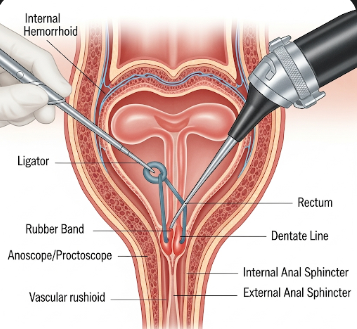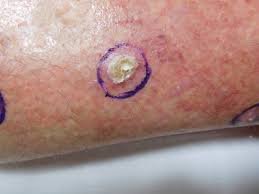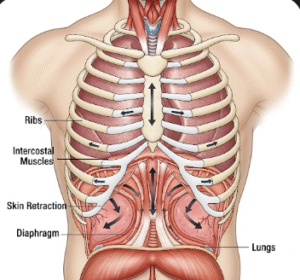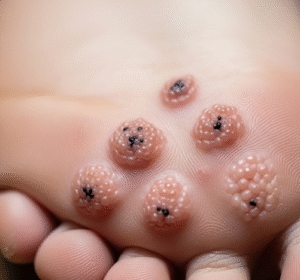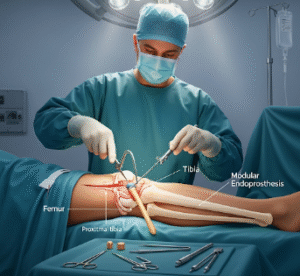Overview
Hemorrhoid banding, also known as rubber band ligation, is a minimally invasive procedure for treating internal hemorrhoids. It involves placing a small rubber band around the base of the hemorrhoid, cutting off its blood supply, causing it to shrink and fall off naturally within days.
South Korea is renowned for advanced gastroenterology centers, experienced proctologists, and high-precision outpatient procedures, making it a top destination for patients seeking safe, effective, and minimally invasive treatment for hemorrhoids.
What is Hemorrhoid Banding?
Hemorrhoid banding involves:
- Insertion of a specialized ligator or anoscope into the anal canal
- Placement of a tight rubber band around the base of the internal hemorrhoid
- Cutting off blood supply, leading to gradual shrinkage and detachment
- Performed as an outpatient procedure with minimal discomfort
Indications include:
- Symptomatic internal hemorrhoids (Grade II–III)
- Persistent bleeding, discomfort, or prolapse
- Patients seeking minimally invasive alternatives to surgical hemorrhoidectomy
What are the Benefits?
- Minimally invasive → No incisions or sutures required
- Outpatient procedure → Usually completed in 10–20 minutes
- Quick recovery → Most patients resume normal activities within a day or two
- High success rate → Effective in controlling bleeding and prolapse
- Low complication rate → Less pain and fewer post-procedure complications compared to surgical hemorrhoidectomy
- Repeatable procedure → Multiple sessions can be performed if needed
Procedure Details
1) How should I prepare for Hemorrhoid Banding?
- Preoperative evaluation → Physical exam, medical history, and anoscopy
- Medication review → Blood thinners may need to be paused
- Dietary preparation → Light bowel preparation may be recommended to ensure a clear anal canal
- Fasting → Not typically required as anesthesia is local
- Pre-procedure consultation → Discuss procedure steps, possible discomfort, and post-procedure care
2) What happens during the procedure Hemorrhoid Banding?
- Anesthesia → Local anesthesia or topical anesthetic to reduce discomfort
- Insertion of anoscope → Visualizes the hemorrhoid inside the anal canal
- Band placement → Small rubber band applied around the base of the hemorrhoid
- Immediate effect → Hemorrhoid loses blood supply and begins shrinking
- Duration → Usually 10–20 minutes
- Monitoring → Minimal monitoring required; patient may sit up and walk immediately
3) What happens after Hemorrhoid Banding?
- Post-procedure care → Mild discomfort, pressure, or bleeding may occur for a few days
- Pain management → Over-the-counter analgesics for mild pain
- Activity restrictions → Light activity immediately; avoid heavy lifting and straining for a few days
- Diet → High-fiber diet and hydration to prevent constipation
- Follow-up visits → Assess hemorrhoid resolution and determine if additional sessions are needed
Risks / Benefits
Risks
- ➤ Mild pain, discomfort, or a feeling of fullness in the rectum
- ➤ Minor bleeding when the banded hemorrhoid falls off
- ➤ Infection (rare)
- ➤ Thrombosed hemorrhoid formation (rare)
- ➤ Urgency or difficulty with bowel movements for a short period
Benefits
- ➤ Minimally invasive and quick procedure
- ➤ Effective treatment for internal hemorrhoids
- ➤ Short recovery time with minimal discomfort
- ➤ Outpatient procedure → No hospital stay required
- ➤ Repeatable for persistent or multiple hemorrhoids
Recovery and Outlook
- Immediate recovery → Mild discomfort and occasional spotting for a few days
- Return to normal activity → Usually within 1–2 days
- Diet and bowel management → High-fiber diet, adequate hydration, and stool softeners if necessary
- Follow-up care → Typically within 2–4 weeks to ensure resolution
- Long-term outlook → Most patients experience significant reduction in bleeding and prolapse; recurrence may require repeat banding sessions
- Lifestyle adjustments → Avoid prolonged sitting, heavy lifting, and straining during bowel movements
South Korea provides comprehensive post-procedure care, including dietary guidance, follow-up anoscopy, and symptom monitoring, ensuring optimal recovery and patient satisfaction.
When To Call the Doctor
Contact your gastroenterologist immediately if you notice:
- ⚠️ Severe pain not relieved by medication
- ⚠️ Heavy bleeding or passage of large clots
- ⚠️ Signs of infection (fever, chills, foul discharge)
- ⚠️ Difficulty urinating or persistent constipation
- ⚠️ Hemorrhoids not shrinking or symptoms worsening
Best Korea Option / Process
South Korea is a leading destination for Hemorrhoid Banding due to:
- Highly skilled gastroenterologists and proctologists
- Advanced anoscopy and banding instruments
- Outpatient procedure with minimal discomfort and rapid recovery
- Comprehensive post-procedure care and follow-up
- International patient support, including hospital coordination, translation, and follow-up guidance
Top Hospitals for Hemorrhoid Banding in Korea:
- Asan Medical Center, Seoul – Expertise in minimally invasive proctology
- Samsung Medical Center – High patient satisfaction with rubber band ligation
- Seoul National University Hospital (SNUH) – Advanced gastroenterology and post-procedure care
- Yonsei Severance Hospital – Specialized outpatient hemorrhoid treatment
👉 For patients with internal hemorrhoids causing bleeding, prolapse, or discomfort, Hemorrhoid Banding in Korea offers a safe, effective, and minimally invasive solution with rapid recovery and excellent outcomes.

